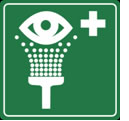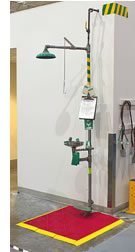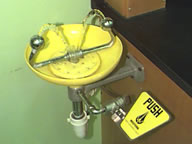- Home
- Public Employees Occupational Safety and Health
- PEOSH Health Standards
- PEOSH Medical Services and First Aid Standard (29 CFR 1910.151)
PEOSH Medical Services and First Aid Standard (29 CFR 1910.151)
The PEOSH Medical Services and First Aid Standard (29 CFR 1910.151(c)) establishes minimum standards for the availability of medical care and first aid, including emergency eyewashes and showers. The Standard states "where the eyes and body of any person may be exposed to injurious corrosive materials, suitable facilities for quick drenching or flushing of the eyes and body shall be provided within the work area for immediate emergency use."
Factors to consider in determining if an emergency eyewash and/or shower is necessary for a substance include:
- length of exposure,
- concentration,
- quantity, and
- use of the substance being handled.
Some sources of information that may be helpful in determining health risk include, but are not limited to:
- the Material Safety Data Sheet (MSDS) or label issued by the manufacturer stating that an eyewash and/or emergency shower be available;
- the New Jersey Department of Health, Right to Know Hazardous Substance Fact Sheet stating that an eyewash and/or emergency shower must be available for one or more chemicals present in the workplace.
PEOSH adopted Medical Services and First Aid Standard (29 CFR 1910.151).
 American National Standards Institute (ANSI) Emergency Eyewash and Shower Equipment Standard ANSI Z358.1-2004. This standard provides the design specifications for emergency shower and eyewash equipment referenced in the standard interpretations. Purchase only.
American National Standards Institute (ANSI) Emergency Eyewash and Shower Equipment Standard ANSI Z358.1-2004. This standard provides the design specifications for emergency shower and eyewash equipment referenced in the standard interpretations. Purchase only.
- What kind of eyewash and/or shower should be in the workplace?
- Where should the eyewash and/or shower equipment be located?
- How do I maintain eyewash and/or shower equipment?
- Who should be trained on the use of emergency eyewash and/or shower equipment?
- What personal protective equipment is needed?
Q: What kind of eyewash and/or shower should be in the workplace?
 A: The first few seconds following an eye injury are often crucial in keeping injury to a minimum. The PEOSH recommends that the American National Standards Institute (ANSI) Publication Z358.1-2004 for emergency eyewash and shower equipment be used for selecting the appropriate eyewash and/or shower equipment. For example, the ANSI standard requires that an approved eyewash capable of providing at least fifteen minutes of continual flushing must be provided in areas where corrosive substances are used. This document is available from ANSI, 11 W. 42nd Street, New York, NY 10036, (212) 642-4900.
A: The first few seconds following an eye injury are often crucial in keeping injury to a minimum. The PEOSH recommends that the American National Standards Institute (ANSI) Publication Z358.1-2004 for emergency eyewash and shower equipment be used for selecting the appropriate eyewash and/or shower equipment. For example, the ANSI standard requires that an approved eyewash capable of providing at least fifteen minutes of continual flushing must be provided in areas where corrosive substances are used. This document is available from ANSI, 11 W. 42nd Street, New York, NY 10036, (212) 642-4900.
Q: Where should the eyewash and/or shower equipment be located?
A: Eyewash stations and/or showers should be placed within the work area for immediate emergency use. ANSI requires that an eyewash must be provided within 100 feet (30.5m) or ten seconds travel time in areas where corrosive substances are used. The unit should be located as close to the hazard as possible, and on the same level. The maximum time required to reach the eyewash should be determined by the potential effect of the chemical. For a strong acid or strong caustic, the eyewash should be immediately adjacent to or within 10 feet of the hazard. It is recommended that a consulting physician be contacted for advice on the proper distance.
Q: How do I maintain eyewash and/or shower equipment?
A: ANSI recommends that all emergency eyewash and shower equipment be checked on a weekly basis in order to ensure proper working condition. Plumbed eyewash units should be activated weekly to flush the line and to verify proper operation. Self-contained eyewash units must be maintained according to manufacturer's instructions. The weekly inspections should be recorded for each unit.
Q: Who should be trained on the use of emergency eyewash and/or shower equipment?
A: Any employee who may be exposed to a chemical splash should be instructed in the proper use of eyewash and shower equipment.
Q: What personal protective equipment is needed?
A: The proper skin and eye protection equipment is needed to ensure that hazardous substances are not splashed into the eyes or absorbed though the skin. Refer to 29 CFR 1910.132 "General Requirements" and 29 CFR 1910.133 "Eye and Face Protection" for requirements of these standards. The type of protection should be listed on the MSDS and the Right to Know Hazardous Substance Fact Sheet for the chemicals used at your workplace. If you have any questions you can contact a personal protective equipment vendor or the PEOSH at (609) 984-1863.


